Virabhadrasana 1,2, 3: Health Benefits,Types, How to do?
What is Virabhadrasana?
Virabhadrasana or Warrior Pose is a group of related lunging standing asanas or yoga positions. The pose is pronounced as Vee- Ra- Bha- Dra-asana. In Sanskrit, Vira = Hero or Warrior or Vigorous and Courageous and Bhadra = good or auspicious. Named after the fierce Warrior Virabhadra, as per the Hindu Mythology, the warrior Virabhadra was formed by Lord Shiva, symbolizing our inner ability to overcome ignorance and ego. Warrior Pose I is one of the three Warrior poses that beautifully blends both the standing and balancing actions of the body. This pose strengthens the arms, shoulders, back, and thigh muscles, all in one go.
Although foundational in nature, what makes Virabhadrasana series powerful, unique, and a bit complex at the same time, is the fact that you are needed to balance simultaneous movements in different directions. Also, it educates us to develop a sense of balance and become more aware of body positioning.
What are the Health Benefits of the Warrior Pose (Virabhadrasana)?
There are some advantages you can achieve :
- Strengthens and tones the arms, lower back, and legs.
- Improves balance in the body, and aids increase stamina.
- Advantageous for those with sedentary or desk bound jobs.
- Extremely advantageous in the case of frozen shoulders.
- Reduces stress in the shoulders very effectively in a short period of time.
- Brings auspiciousness, grace, courage, and peace.
What are the Types of virabhadrasana and how to do it?
There are 3 types of Virabhadrasana or Warrior Pose:
- Virabhadrasana I
- Virabhadrasana II
- Virabhadrasana III
Virabhadrasana I
Benefits Of Virabhadrasana I:
- This asana strengthens back muscles, butts, and hamstrings and aids with improving balance.
- Raising your torso and arms up aids build strength in the arms, shoulders, and back.
- Strengthens biceps and triceps and aids open and creating strength and stability in the shoulder joints.
- This pose tones the abdomen and outer hips.
- Strengthens the hip extensors and opens the hip flexors.
- Engages the deep core muscles, which aids create stability and improving balance.
Preparatory pose for Virabhadrasana I:
- Vrikshasana
How to do Virbhadrasna I?
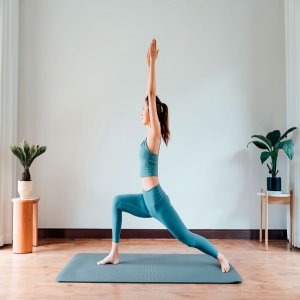
Stand upright with your legs wide apart.
Rotate one foot by 90 degrees outwards and the other foot in by about 15 degrees.
Ensure that the heel of the foot that is turned 15 degrees, is lined up to the centre of the other foot.
Put your hands on your hips and rotate your shoulders, chest, and pelvis forward. Upper body facing the front of the mat.
While inhaling, draws the arms from the sides over your head. Maintain your palms in a namaste pose over your head.
Bring your shoulders down the back while maintaining the back leg firmly.
Flex the back knee and exhale deeply maintaining it directly in line with the other ankle.
The thigh should be parallel to the floor. Make sure the flexed knee does not pass the ankle and the big toe is visible.
Arch your back and fall your head back, gaze upwards towards the namaste position.
Ground down the front foot ensuring the outer edge of the foot is pressed firmly on the mat. This will allow the weight to transfer backward.
Move your tailbone toward the pelvis and engage your abdomen.
Hold the pose for 10-20 seconds.
Inhale and extend your back leg; then exhale and release your arms, stepping your feet together. Change sides and repeat the same steps.
Follow up poses for Virabhadrasana I:
- Balasana
- Adho Mukha Svanasana
Beginners’ tips for Virabhadrasana I:
- Find a comfortable and stable stance to begin.
- To avoid the front knee from collapsing in, wrap the muscles around the outer hip to laterally rotate the leg.
- To avoid the ribs from flaring out, engage the core and move the tailbone down towards the mat, which also keeps the lower back straight.
Contraindications Of Virabhadrasana I:
- High blood pressure patients should prevent this posture.
- If you have neck issues, keep your head in a normal position and don’t up at your thumbs.
- People with heart problems should prevent this posture.
- If you have knee pain or knee injury prevent this posture.
Variations for Virabhadrasana I:
During Sun Salutations, try with different arm positions for Warrior 1 such as hands in prayer pose (Anjali Mudra) or clasping your hands behind your back.
Come into a Humble warrior pose by bringing your torso down on the inside of your flex leg, hands clasped behind you, arms straight and raised.
How to do Virbhadrasana I by watching a video?
Virabhadrasana II
Benefits Of Virabhadrasana II:
- Strengthens your shoulders, arms, back, legs, and ankles.
- Opens your chest, hips, and lungs.
- Improves concentration, balance, and stability.
- Stimulates good circulation and respiration.
- Stretches your arms, shoulders, legs, belly, neck, groins, and ankles.
- Energizes the whole body.
- Activates your abdominal organs.
Preparatory Poses for Virabhadrasana II:
- BaddhaKonasana
- Vrikshasana
- Supta Padangusthasana (Reclining Hand-to-Big Toe Pose
- Anjaneyasana (Low Lunge)
- Prasarita Padottanasana (Wide-Legged Standing Forward Bend)
How to do Virbhadrasana II?
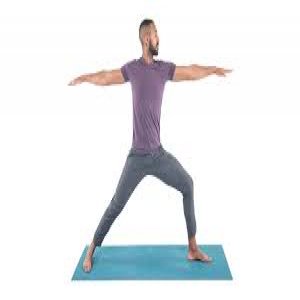
This asana is done in the standing posture similar to the previous version.
Stand with your legs wide apart and rotate your right foot out by 90 degrees and left foot in by around 15 degrees.
Ensure that the heel of the right foot is lined up to the centre of the left foot.
Inhale and raise both arms sideways to shoulder level with your palms facing upwards. Arms parallel to the floor.
Exhale and flex your right knee. The ankle and same knee should be aligned in one line.
Ensure the knee does not go beyond the ankle.
Rotate your head and concentrate on your right middle finger.
As you settle down in the yoga pose, stretch your arms further.
Make a small effort to push your pelvis down.
Hold this pose with confidence.
Inhale and extend your right knee and slowly come up.
Exhale, and draw your hands down from the sides.
Repeat the yoga pose for the opposite leg and side.
Follow up Poses for Virbhadrasana II:
- Uttitha Trikonasana
- Parsvottanasana
- Tadasana (Mountain Pose)
- Uttanasana (Standing Forward Bend)
- Supta Baddha Konasana (Reclining Bound Angle Pose)
Beginner Tips for Virbhadrasana II:
Practicing Warrior II correctly needs concentration on various points of alignment. Keep the following matters in mind when performing this pose:
- Work on getting the leg and foot placement first. Build the pose from the ground up.
- Ensure your front knee stays aligned with your front ankle. Do not permit the knee to drift to the left — this can strain the knee joint. Instead, imagine it lightly moving out toward the baby toe.
- Keep your concentration on a single point.
Variation of Virbhadrasana II:
- Warrior II against a wall – To aid maintain your balance in this pose, perform it with a block between your thigh and a wall. Compress your thigh into the block for stability. This variation also trains your front knee to not sag in toward the centre of your body.
Contraindications Of Virabhadrasana II:
The following precautions should be taken while performing Virabhadrasana II.
- High blood pressure patients should prevent this posture.
- Virabhadrasana especially advantages pregnant ladies in their second and third trimesters provided they have been practicing yoga daily.
- Perform Virabhadrasana while standing close to a wall, so you can support yourself if needed.
- However, do consult your doctor before performing this yoga posture.
- If you have knee pain or arthritis, take some support at the knee to hold this yoga posture.
How to do Virbhadrasana II by watching a video?
Virabhadrasana III
Benefits Of Virabhadrasana III:
- Strengthens your back muscles, legs, thighs, knees, and ankles.
- The balancing act increases coordination and focus.
- The core muscles profited from this asana.
- Hip muscle, abdomen, and arms are toned.
- Reduces stiffness in the neck, shoulders, and back.
- Decreases stubborn fat from hips.
Preparatory Poses for Virbhadrasana III:
- Uttkatasana
- Vrikshasana
- Urdhva Hastotanasana
- ArdhaChandrasana
- Supta Padangusthasana (Reclining Hand-to-Big-Toe Pose)
- Plank Pose
- Anjaneyasana (Low Lunge)
- High Lunge
- Urdhva Prasarita Eka Padasana (Standing Splits)
- Parsovottanasana (Intense Side Stretch)
- Utkatasana (Chair Pose)
- Navasana (Boat Pose)
How to do Virbhadrasana III?
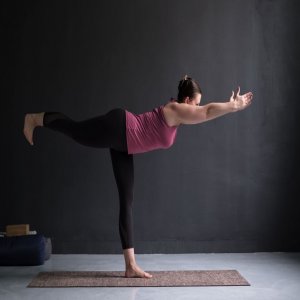
Stand straight with your feet together and put your hands on the waist.
Inhale slowly and transfer your body weight to the leg that you would like to place firmly on the floor.
Raise your other leg and simultaneously flex forward.
Make sure your torso and the leg are parallel to the floor.
You can now draw your hands together and make a namaste pose with your hands.
Hold this pose for three minutes, to start with, and up to five minutes when you begin mastering this pose.
Perform your breathing exercise too while retaining the pose.
You can perform the same pose by trying the other leg, provided you are confident of balancing.
Follow up Poses for Virbhadrasana III:
- Tadasana
- Uttanasana
- Adho Mukha Svanasana
- Balasana (Child’s Pose)
Beginner’s tips for Virabhadrasana III:
- If the hip bone of your raised leg raises during the pose, release that hip toward the ground until both hip points are even and parallel to the ground. Energize your back leg and straighten it strongly toward the wall behind you as you reach just as actively forward with your arms.
- When you extend the front knee, imagine that the front calf is resisting forward against the shin; this will avoid the knee from locking or hyper extending.
Variation of Virbhadrasana III:
There are several options that help reach Virabhadrasana 3 step by step.
- You may stop raising your leg to the degree that feels comfortable for you. You may even begin by keeping the tips of your toes on the floor and leaning forward only slightly, remaining the upper body and back leg in line. From practice to practice, you will be able to lean forward more and raise the back leg further.
- You may use a chair to gently grab onto to help you with the balance. Make sure you do not put them on the chair but keep the arms engaged.
- You may put your back foot against a wall. This will aid your balance while you actively push your foot away from you into the wall, engaging your leg muscles and core.
- If you notice that extending your arms above your head causes you to lose balance, then you may either bring your hands to center in Anjali Mudra, move your arms sideways or move your arms backward like the wings of an airplane, palms facing towards the floor. The latter option will aid you to open your chest and ease your neck and shoulders if you struggle with tightness or soreness in that area.
- If it feels good with your shoulders and neck while your arms reach forward, you may also clasp your hands and point your index fingers (Kali Mudra).
Common Mistakes done during Virabhadrasana III:
Prevent these errors so you get the most from this pose and avoid strain or injury.
Locking or Hyper extending Supporting Knee
Keep your assisting knee slightly soft to protect the joint. Instead, focus on the calf muscle resisting the shin muscle to support the body.
Upper Leg Too High
You should aim for your whole body to be parallel to the floor in a straight line. Lifting your upper leg too high will stress the lower back or result in your head tipping down.
Neck Position
Your head should be in line with your upper body and spine, not cranked up or nodded down, which can put stress on your neck. Keep your gaze down and the upper part of your head pointed at the opposite wall.
Contraindications of Virabhadrasana III:
- High blood pressure patients should prevent this posture.
- If you have knee pain, neck or shoulder pain, or heart problems, prevent this posture.
- If you suffer from spinal problems avoid this posture.
How to do Virabhadrasana III by watching a video?
What are the Variations of Virabhadrasana?
There are 2 variation of Virbhadrasana:
- Baddha Virabhadrasana
- Viparita Virabhadrasana
Baddha Virabhadrasana
What is Baddha Virabhadrasana?
Baddha Virabhadrasana, Humble Warrior Pose, Devotional Warrior Pose, Bound Warrior Pose, or silver surfer pose.
Baddha Virabhadrasana is a forward bending asana that needs flexibility in the hips, legs, back, and shoulders. The name of this asana derives from the Sanskrit roots, baddha, which means “bound,” vira, which defines “hero,” Bhadra, which refers to “friend,” and asana means “pose.” Virabhadra is also the name of a Hindu warrior.
Benefits of Humble Warrior Pose (Baddha Virabhadrasana):
The following physical and mental advantages are listed with the practice of this challenging yoga posture:
Physical Benefits:
- Tones the abdominal organs.
- Elongates the spine.
- Strengthens the thighs, feet, and calves.
- Stretches the sides of the body.
- Opens the hips.
- Opens the chest.
- Strengthens the hip, ankle, and knee joints.
- Activates the thyroid and parathyroid glands.
- Aids alleviate symptoms of carpal tunnel syndrome in the wrists and forearms.
- Improves balance.
Mental Benefits:
- Relieves stress, mild depression, and anxiety.
- Improves clarity
Steps for Humble Warrior Pose (Baddha Virabhadrasana):
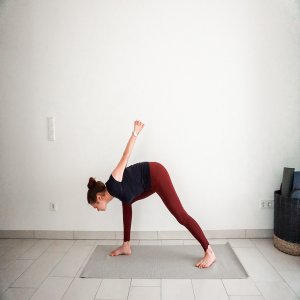
Start in Tadasana (mountain pose) with your feet together and arms on either side of your body.
Distribute the weight equally in your feet. If you have a difficulty staying balanced here stand with the feet parallel and your hip distance apart.
On an exhalation step your left leg around 4 to 5 feet in back of you and turn that back foot at around a 45-degree angle so that the toes are pointed towards the upper left corner of your mat.
The front toes are pointed forwards and are aligned with the front edge of your mat.
You need to have a heel-to-heel alignment between the feet. For more stability, you can move the right foot out to the right a few inches.
Keep the hips rolled towards the front of your mat.
On an exhale, flex the right knee to 90 degrees so that the knee is directly over your ankle and the shin is perpendicular to the earth. Distribute the weight equally through that front foot as you raise the inner arch and root down through the corners of the feet.
Engage the quadriceps of the back leg. The leg should be extended without locking out the knee. Rest the outer edge of the back foot into the earth as you press into the big toe mound.
On an inhale, raise the arms up above the head. Widen the collarbones. Move the shoulders away from the ears.
Elongate the tailbone down towards the earth as you move the navel gently in and up towards the spine. Tuck the lower ribs inward.
On your next breath in, circle your arms behind the back, clasp the finger and bring the palms of the hands together. Gently flex back and shine the heart up towards the sky.
On an exhale, keeping the leg exactly as they are and keeping a long spine fold the torso forward from the hips and raise the knuckles towards the sky. The upper body is on the inside of the right knee.
To release the posture, breathe in and use the strength of your belly to draw the torso back up, straighten the front leg, and release the hands and return to mountain pose. Do it on the left side.
Counterposes for Humble Warrior Pose (Baddha Virabhadrasana):
- Uttanasana (Standing Forward Bend Pose)
- Adho Mukha Svanasana (Downward-Facing Dog Pose)
Contraindications for Humble Warrior Pose (Baddha Virabhadrasana):
Humble Warrior Pose (Baddha Virabhadrasana) is a powerful standing pose that is a combination of forwarding bending as well as balance. To prevent injury to yoga practitioners, precautions should be kept in mind while doing this yoga asana. There are differences for the following:
High blood pressure and heart disease
Since breathing can be restricted when trying to flex the body forward and keep it in balance, it is recommended for physicians with hypertension, heart disease, and vertigo to prevent this yoga pose.
Injury and surgery
With the practice of Humble Warrior Pose (Baddha Virabhadrasana), all the muscles and joints of the body feel very stretched. Therefore, if individuals are suffering from injury to any region of the body, or are recovering from recent surgeries, they should prevent practicing this yoga pose. There are chances of injuries to the neck, shoulders, wrists, lower back, hips, knees, ankles, feet, pelvis, etc., so this yoga practice should be avoided.
Lower back pain and arthritis
A person who has lower back pain is severe, or people with arthritis should avoid doing this yoga pose to avoid inflammation or swelling of the muscles, ligaments, or tissues of the area concerned.
Pregnant women
Women who become pregnant should prevent the practice of this yoga pose with pressure in the abdominal area and deep stretches of pelvic floor muscles which will cause discomfort with breathing affecting the fetus.
Slip disk, cervical spondylosis, and spondylolisthesis
Individuals recovering from a herniated disc from cervical spondylosis or spondylolisthesis shouldn’t the practice Humble Warrior Pose (Baddha Virabhadrasana), as the neck is flexed forward, along with a stretch in the spinal muscles.
Viparita Virabhadrasana
What is Viparita Virabhadrasana?
Viparita Virabhadrasana, Reverse Warrior Pose, is a variant of Virabhadrasana II, with the torso and forward arm tilted backward. The lower arm may extend down the rear leg, or it may reach around the back to the opposite hip.
Viparita Virabhadrasana arrives from the combination of the Sanskrit words Viparita(Inverted or Reversed), Virabhadra(Name of a furious warrior who is an avatar of the Hindu god Shiva) and asana (posture or pose). It is called as Reverse Warrior Posture or Dancing Warrior Pose in English. Also Known As Proud Warrior, Peaceful Warrior, and Crescent Pose.
Benefits of Reverse Warrior Pose:
- Strengthens the lower body.
- Stretches the arms and the side of the upper body.
- Improves perseverance.
- Strengthens the neck, arms, and quads.
- Stretches the oblique, groins, and hips.
- Opens the chest, shoulders, and hips.
- Strengthens the legs.
- Slowly massages the abdominal organs. This increases the digestion system.
- Calms the brain and provides peace of mind.
- It is a great stress reliever.
Preparatory Poses for Viparita Virabhadrasana:
- SuptaVirasana
- UpavisthaKonasana
- Vrksasana
- Adho Mukha Svanasana
- Virasana
- Parivrtta Parsvakonasana
- Supta Padangusthasana
- Gomukhasana
- Virabhadrasana II
- Supta Baddha Konasana
- Utthita Parsvakonasana
- Parivrtta Trikonasana
- PrasaritaPadottanasana
Steps for Reverse Warrior Pose:
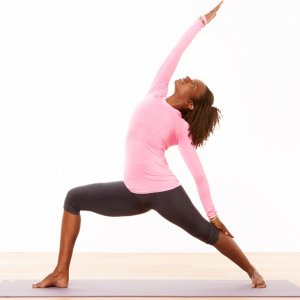
Begin with forming the Warrior II pose on the yoga mat.
Let’s see with the right knee flex.
Move your left hand down to place it on the left leg.
Inhale; Up your right arm towards the ceiling.
Ensure that fingers are away from each other.
Breathing should be normal.
Remain the right knee flex.
Compress into the feet with your legs strong.
Slowly drop your hips down towards the yoga mat.
Slowly relax your shoulders.
Breathing should be normal.
Stay in this position for a few seconds (20 to 60 seconds).
Finish the pose by inhaling and come back to the Warrior II pose.
Repeat all of the above steps with the other side.
Performing this pose thrice (on both sides) will give better results.
Follow-up Pose for Reverse Warrior Pose:
- Virabhadrasana III
Variations & Modifications for Reverse Warrior Pose:
Similar to the majority of the yoga positions conducted, you can do Viparita Virabhadrasana in various ways. This way you can learn to perform the correct form. As you progress, you can increase the difficulty to achieve more health benefits.
- In case, you find it difficult to balance your body, then look at your left foot rather than the right fingertips. If you feel a bit wobbly, then put your feet a bit wide towards either side of the yoga mat.
- You can further improve your challenge. To achieve this, bind your left arm right behind your back. Touch for the inner right thigh with your left hand. Once getting connected, you should use the traction for opening your chest towards the roof.
Tips for beginners to follow when performing Viparita Virabhadrasana:
- Keeping your back foot grounded can be a hard task.
- You may position yourself near a wall and concentrate on keeping your foot grounded.
- This can be gained by pushing your foot against the wall.
- Performing this yoga daily will yield better results.
- It’s good to perform this pose in the morning with an empty stomach.
- Always listen to the body, and know your limits. While practicing, if you find any discomfort or pain, please end the pose and ask for the expert’s guidance and doctor’s advice.
Common Mistakes done while performing Viparita Virabhadrasana:
Avoid these errors so you get the most out of this pose and avoid strain or injury.
Knee Too Far Forward or Drifting Inside
As with any lunge position, the forward knee should never be straight past the toes or you may place too much stress on the knee. Your knee may tend to shift toward the inside, but this is also burdensome on the knee joint and you should keep it from doing so.
Front Knee Not Flexed Enough
Keep your right knee flexed directly over your ankle. A lot of times as you lean your torso backward, the front knee goes with it. After you have placed your arms, check in on your legs and then deepen the front knee so that it is directly over the ankle if necessary. Make a conscious effort to keep a deep bend in your front knee.
Placing Weight on Back Hand
Don’t give any weight on your backhand because your support should arrive from your core strength instead of from your hand resting on your leg.
Precautions To Be Taken While performing The Viparita Virabhadrasana:
You should not perform this asana if you suffer from the following:
- If you have some chronic medical condition. You should consult your doctor before performing the asana.
- If you suffer from a neck issue, then look straight ahead.
- High blood pressure.
- Diarrhea
- If you suffer from imbalance.
- If you experience injuries in your shoulders, spine, back, knees, or hips.
- You are likely to experience some stretch in your sides, groin, and thighs. With daily practice, the pain felt in these areas with disappear. If it does not, stop performing this exercise and consult a doctor.
What are the Contraindications of the Warrior Pose (Virabhadrasana)?
There is some contraindication for virabhadrasana:
- Perform Warrior Pose (Virabhadrasana) only after consulting your doctor if you have experienced spinal disorders recently or just recovered from chronic problems.
- High blood pressure patients should prevent this posture.
- Virabhadrasana especially advantages pregnant ladies in their second and third trimesters provided they have been practicing yoga daily. Perform Virabhadrasana while standing close to a wall so you can support yourself if needed. However, do consult your doctor before performing this yoga posture.
- Prevent this posture if you are suffering or had recently suffered from diarrhea.
- If you have knee pain or arthritis, use some support at the knee to stay in this yoga posture.

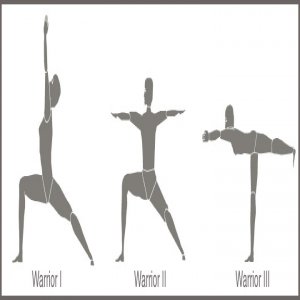
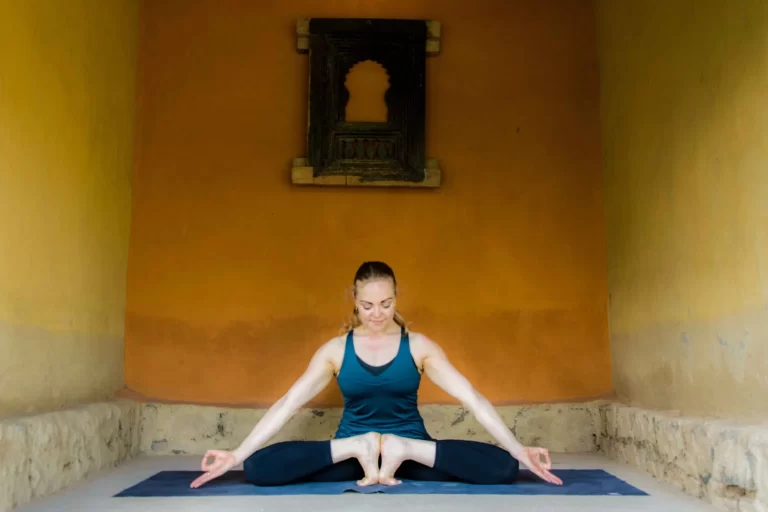

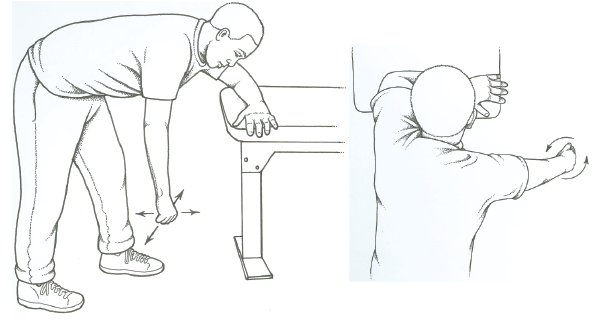
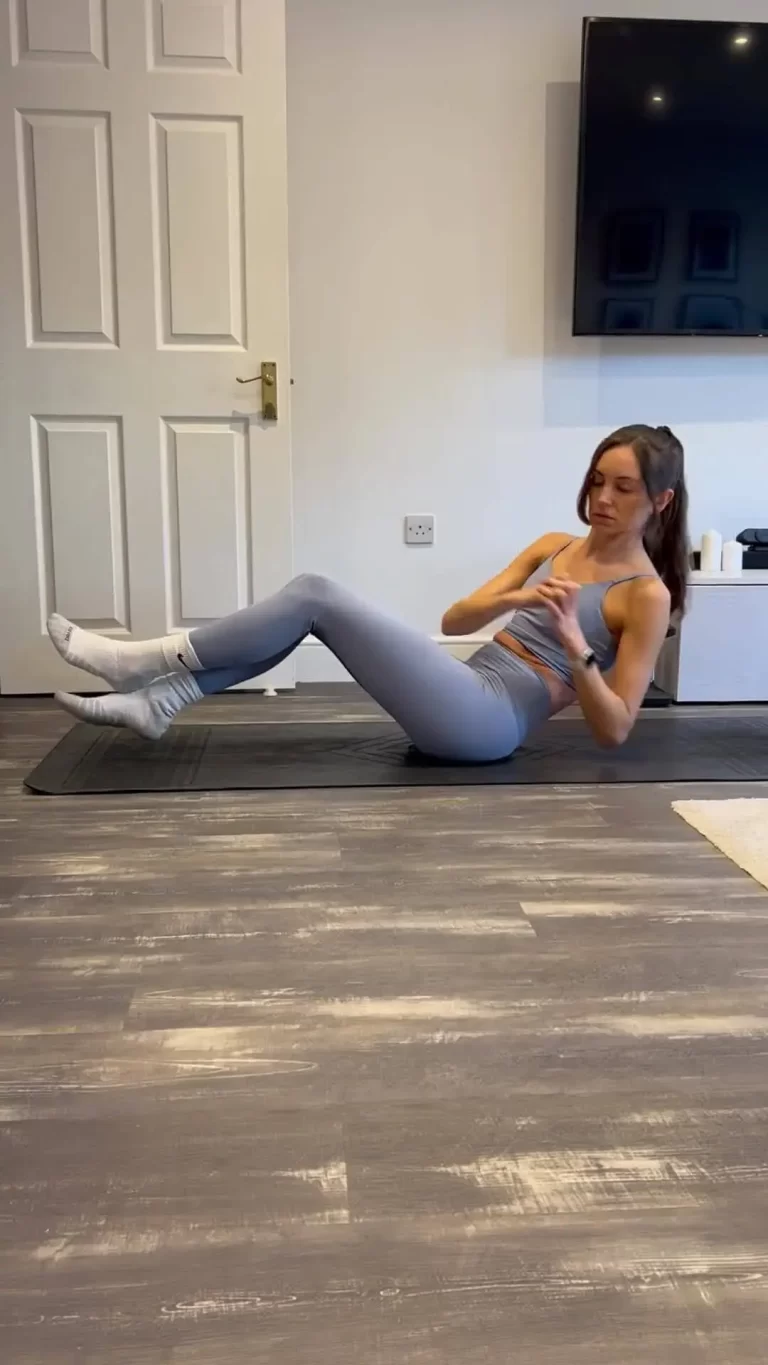
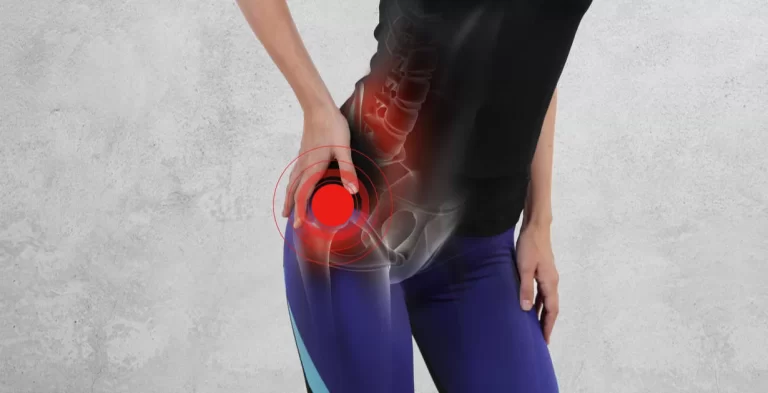
2 Comments